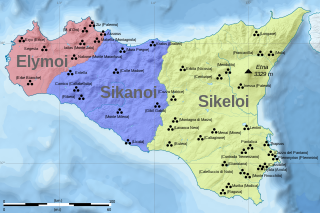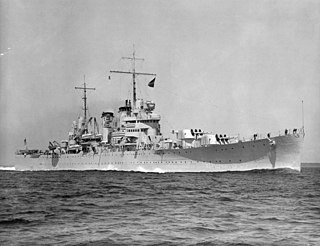
Gelon also known as Gelo, son of Deinomenes, was a 5th-century BC ruler of Gela and Syracuse and first of the Deinomenid rulers.

The Allied invasion of Sicily, codenamed Operation Husky, was a major campaign of World War II, in which the Allies took the island of Sicily from the Axis powers. It began with a large amphibious and airborne operation, followed by a six-week land campaign, and initiated the Italian Campaign.

Gela, is a city and comune in the Autonomous Region of Sicily, the largest for area and population on Sicily's southern coast. It is part of the Caltanissetta province, being the only comune in Italy with a population and area that exceeds those of the province's capital. Founded by Greek colonists from Rhodes and Crete in 689 BC, Gela was an influential polis in Sicily between the 7th and 6th centuries and the place where Aeschylus lived and died in 456 BC. In 1943 Gela was the first Italian beach reached by allies during the Invasion of Sicily from the allies.

Licata, formerly also Alicata, is a city and comune located on the south coast of Sicily, at the mouth of the Salso River, about midway between Agrigento and Gela. It is a major seaport developed at the turn of the twentieth century, shipping sulphur, the refining of which has made Licata the largest European exporting centre, and asphalt, and at times shipping cheese.

The Province of Caltanissetta is a province in the southern part of Sicily, Italy. Following the suppression of the Sicilian provinces, it was replaced in 2015 by the Free municipal consortium of Caltanissetta. It contains 22 comuni, which are listed at Comuni of the Province of Caltanissetta. Its coat of arms is a red crest and two green leaf stems on top with a laurel leaf on the right and a crown in the middle. The River Salso is the main river of the province; it is 122 kilometres (76 mi) long and originates in the province of Palermo, and it flows into the Mediterranean in this province at the end of the Gulf of Gela.

The Sicani or Sicanians were one of three ancient peoples of Sicily present at the time of Phoenician and Greek colonization. The Sicani dwelt east of the Elymians and west of the Sicels, having, according to Diodorus Siculus, the boundary with the last in the ancient Himera river (Salso) after a series of battles between these tribes.

The Battle of the Himera River was fought in 311 BC between Carthage and Syracuse near the mouth of the Himera river. Hamilcar, grandson of Hanno the Great, led the Carthaginians, while the Syracusans were led by Agathocles. Agathocles initially surprised the Carthaginians with an attack on their camp, but the Greeks lost the battle when they were attacked by unexpected Carthaginian reinforcements. The Greek army took many casualties as it retreated. Agathocles managed to gather the remains of his army and retreat to Syracuse, but lost control of Sicily.
S.S.D. Città di Gela, commonly known as just Gela, is an Italian association football club, based in Gela, Sicily.

Santa Cristina Gela is an Arbëreshë village in the Metropolitan City of Palermo in Sicily.

The Salso, also known as the Imera Meridionale, is a river of Sicily. It rises in the Madonie Mountains and, traversing the provinces of Enna and Caltanissetta, flows into the Mediterranean at the western end of the Gulf of Gela at the seaport of Licata, in the Province of Agrigento. Its small deltaic system there is dominated by marine processes rather than fluvial ones. It is a seasonal torrent, with brief but violent floods during the winter rains, and all but dry in summer droughts. In November 1915 the iron bridge across the river's mouth collapsed during floods, and 119 people were swept away in the flood and lost. The Salso, which is the longest river of Sicily at 132 kilometres (82 mi), has a drainage basin area of 2,022 square kilometres (781 sq mi).

The Sicilian Wars, or Greco-Punic Wars, were a series of conflicts fought between ancient Carthage and the Greek city-states led by Syracuse, Sicily over control of Sicily and the western Mediterranean between 580–265 BC.

The Dirillo, or Acate, is a 54-kilometre (34 mi) river in Sicily which springs from the Hyblaean Mountains and flows through the areas of Vizzini, Licodia Eubea, Mazzarrone, Chiaramonte Gulfi, Acate, Vittoria, Gela. It enters the Strait of Sicily south-east of the town of Gela. As the largest river in the area it is sometimes known as the Fiume Grande.
The Battle of Gela took place in the summer of 405 BC in Sicily. The Carthaginian army under Himilco, which had spent the winter and spring in the captured city of Akragas, marched to confront the Greeks at Gela. The Syracuse government had deposed Daphnaeus, the unsuccessful general of the Greek army at Akragas, with Dionysius, another officer who had been a follower of Hermocrates. Dionysius schemed and gained full dictatorial powers. When the Carthaginians advanced on Gela and put the town under siege, Dionysius marched from Syracuse to confront the threat. He planned to use a complex three-pronged attack plan against the Carthaginians, which failed due to lack of proper coordination. Dionysius chose to evacuate Gela, as the defeat caused discontent in Syracuse and he did not wish to lose his power. Himilco sacked the abandoned city after the Greeks had fled to Camarina.

The 4th Infantry Division Livorno was a mountain infantry division of the Italian Army during World War II. The division was formed on 5 April 1939 in Rome. The only difference between line infantry divisions and mountain infantry divisions was that the latter's artillery was carried by pack mules instead of the standard horse-drawn carriages. Italy's real mountain warfare divisions were the six alpine divisions manned by the "Alpini" mountain troops.

Akrillai and Akrilla, Acrillae was an ancient Greek colony located in the modern province of Ragusa, Sicily, Italy, where the town of Chiaramonte Gulfi stands today. The ruins of the old colony can be found in the contrada (quarter) Piano del Conte-Morana and Piano Grillo. A necropolis dating from the 6th-5th century BC has been identified in the contrada Paraspola-Pirruna.
The Sack of Camarina in Sicily took place in 405 BC as part of the Sicilian Wars.

Cassibile is an Italian village and civil parish (frazione) of the city and municipality (comune) of Syracuse (Siracusa), in Sicily. As of 2006 its population was of 5,800.

The amphibious Battle of Gela was the opening engagement of the American portion of the Allied Invasion of Sicily during World War II. United States Navy ships landed United States Army troops along the eastern end of the south coast of Sicily; and withstood attacks by Luftwaffe and Regia Aeronautica aircraft while defending the beachhead against German tanks and Italian tanks of the Livorno Division until the Army captured the Ponte Olivo Airfield for use by United States Army Air Forces planes. The battle convinced United States Army officers of the value of naval artillery support, and revealed problems coordinating air support from autonomous air forces during amphibious operations.

Rosario Crocetta is an Italian politician. He was the first openly gay mayor in Italy when he became Mayor of Gela in 2003, a post he held until 2009. A prominent figure in the fight against the Mafia, in 2009 he was elected as a Member of the European Parliament (MEP). He became President of Sicily between 2012 and 2017 following the Sicilian regional elections of 2012, thus becoming the second openly gay head of a regional government in Italy after Nichi Vendola.

















